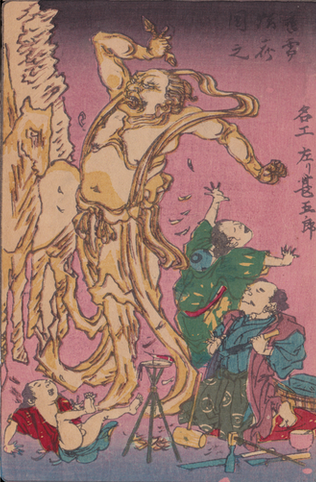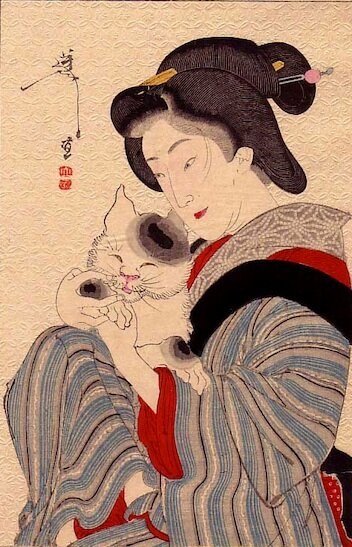Gallery 2: Ukiyo-e and Meiji Prints
Kuniharu (Utagawa Yoshimori, 1830-1884)
A mameban (“bean print”). 1850s 7.5 x 11.4 cm
This gallery includes a small number of woodblock prints from the ukiyo-e tradition of the Edo era as well as some prints from the Meiji era . Ukiyo-e translates as “pictures of the floating world” and portrays the pleasurable activities of the merchant class which rose to economic influence in the 17th century. Images depict tea houses, courtesans, geisha, kabuki theater, sumo wrestlers, birds and flowers, folk tales, history, erotica, and travel scenes. Interest in Ukiyo-e faded among the Japanese following the Meiji Restoration (1868).
Miniature ukiyo-e prints frequently appeared in books (e-hon) and erotica (shunga), neither which are a significant focus of this collection. They are otherwise uncommonly encountered as most prints of the era were in the larger oban (approximately 25 x 38 cm), aiban (34 x 22.5 cm), or chuban (19 x 25 cm) formats. Several artists such as Hokusai and Hiroshige produced series in the koban (13 x 23 cm) format. Mameban (“bean prints”) of kabuki actors are also occasionally encountered.
The collection includes additional kabuki prints by Toyohara Kunichika which can be viewed in Gallery 2A.
Examples of Ukiyo-e reproductions, which are commonly encountered in miniature formats derived from the original larger prints, can be viewed in Gallery 2B.
Adachi Ginkō (1853-?)
Party in Honor of Ebisu. 1894. 17.3 x 11.2 cm
Adachi Ginkō (1853-?)
Cat's Party. 1894. 17.5 x 11.2 cm
Adachi Ginkō (1853-?)
Monkey Party. 1894. 16.9 x 11.2 cm
Adachi Ginkō (1853-?)
Cherry Blossoms in Full Bloom. 1894. 17.2 x 11.2 cm
Inoue Yasuji (1864-1889)
Toshogu Shrine in Snow. Yasuji was a Meiji era artist but is usually including in discussions of Ukiyo-e as he was a student of Kobayashi Kiyochika (1847-1915), one of the last Ukiyo-e artists. This image likely printed in mid 1920s-1930s (Made in Japan stamped on backing paper). 13.6 x 8.4 cm
The following nine prints are from the series True Pictures of Famous Places in Tokyo by Inoue Yasuji (1864-1889). The original series was printed in 1884. These prints are from recut blocks dating to the 1960s.
Plum Garden in Kameido. 15.4 x 9.6 cm
Zōjōji in Shiba. 15.4 x 9.5 cm
Hashiba Ferry. 15.4 x 9.6 cm
The two images to the left are pirated from the series True Pictures of Famous Places in Tokyo. They are signed Hiroshige, an obvious misattribution to the earlier Ukiyo-e artist. These prints are smaller than the originals. The print on the left was affixed to an undated greeting card. The composition for that image is also very similar to the middle third of a vertical design by Kobayashi Kiyochika. A postcard set of these two images plus one additional image can be seen in Gallery 9.
Katsushika Hokusai (1760-1849)
Fujisawa from Fifty-Three Stations of the Tōkaidō Road. 16.3 x 11.6cm. Originally 1804 (later edition)
Katsushika Hokusai (1760-1849)
Ryōgoku no sekisho. From Furyu Sumidagawa Hakkei. 1819. Hayashi collector seal. 17.3 x 11.0 cm
Kawanabe Kyōsai (1831-1889)
A Kite GIves Birth to the Child of a Hawk, Sharp-eyed as a Cormorant or Hawk. A print referencing two proverbs. From One Hundred Pictures by Kyôsai. 1863-1866. 12.2 x 17.1
Kawanabe Kyōsai (1831-1889)
A Kite GIves Birth to the Child of a Hawk, Sharp-eyed as a Cormorant or Hawk. A print referencing two proverbs. From One Hundred Pictures by Kyôsai. Pink sky version. 1863-1866. 12.2 x 17.1
Kawanabe Kyōsai (1831-1889)
From One Hundred Pictures by Kyôsai. 1863-1866. 11.5 x 7.4 cm
Kawanabe Kyōsai (1831-1889)
The Conquest of Korea from One Hundred Pictures by Kyōsai. Published by Wakasaya Yoichi. 1863. 11.3 x 17.0 cm.
Kawanabe Kyōsai (1831-1889)
UUnidentified print from One Hundred Pictures by Kyōsai. Published by Wakasaya Yoichi. 1863. 11.3 x 17.0 cm
Kawanabe Kyōsai (1831-1889)
The Great Sculptor Hidari Jingorô from One Hundred Pictures by Kyōsai. Published by Wakasaya Yoichi. 1863. 11.2 x 17.0 cm
Keisai Eisen (1790-1848)
A surimono (poetry circle print). c1830. 11.1 x 18.1 cm
Kinoshita Hironobu (Fl. 1851-1870)
Six mameban (bean print) images from an uncut hosoban (37.0 x 17.0 cm) sheet published in 1862. Mameban prints were almost always cut into smaller single image sheets. For this reason, they are presented here as if they had been separated.
Kobayashi Kiyochika (1847-1915)
Burnt Ruins of the Ryōgoku Bridge Area. 15.4 x 9.5 cm
Mizuno Toshikata (1866-1908)
From Bijutsu Magazine. 1890s. 13.2 x 19.4 cm
Mizuno Toshikata (1866-1908)
From the art magazine Bijutsu-sekai, issue 17. Published by Shunyodo. Edited by Watanabe Seitei. 1891. 13.3 x 19.5 cm
Ogata Gekkō (1859-1920)
Dance. A smaller reformatted version of an Oban print from the series Gekko Zuihitsu (Gekko's Essay). 15.9 x 18.0 cm
Sadahiro II (Hirosada II)
Ōtomo no Kuronushi and Ariwara no Narihira from the series Parody Six Poetic Immortals. 1860s. 10.8 x 17.0 cm
Sekkei
Nakamura Tamashichi I (active on stage 1848-1860) as Ko Murasaki in the play Gonza Gonpachi Hanashi mo Yoshiwara. A mameban (“bean print”). Published in Ōsaka in 1855, 3rd month. 7.1 x 10.9 cm
Toyohara Chikanobu (1838-1912)
Farmer Shimamoto Sakuzō from Edo Saki Village. Undated. 10.1 x 15.2 cm
Tomioka Eisen (1864-1905)
Planting Rice in the Rain. Catalogue description: “They are planting young rice in the rain, singing a charming song as they work.” Published by Matsumoto, Tokyo. No. 390 in Matsumo Catalogue. 1910. 11.6 x 18.1 cm
Tomioka Eisen (1864-1905)
From the art magazine Bijutsu-sekai, issue 17. Published by Shunyodo. Edited by Watanabe Seitei. 1891. 13.3 x 19.4 cm
Tomioka Eisen (1864-1905)
Ships at Night. Published by Matsumoto, Tokyo. No. 301 in Matsumoto Catalogue. 1910.11.5 x 18.1 cm
Tsukioka Yoshitoshi (1839-1892)
Looking Cute from the series Thirty-Two Customs and Manners. Post-Humous Miniaturization of the original oban sized print. 1930s. 9.3 x 13.7 cm
Tsukioka Yoshitoshi (1839-1892)
Bijin-ga from an art book. 1890s. 11.4 x 17.9 cm
Tsukioka Yoshitoshi (1839-1892)
Bijin-ga from an art book. 1890s. 11.6 x 17.7 cm
Utagawa Hiroshige (1797-1858)
Fireworks at Ryogoku from Famous Places in Edo. 1845
Utagawa Hiroshige II (1826-1869)
Travelers at Kameyama. From Fifty-three Stations of the Tōkaidō Road. 1854. 16.8 x 11.6 cm
Utagawa Hiroshige II (1826-1869)
Ishiyakushi from Fifty-Three Stations of the Tōkaidō Road. 1854. 16.9 x 10.9 cm
Utagawa Kuninao (1793-1854)
Illustration from Chapter 46: Shiigamoto from The Tale of Genji. c 1845. 12.0 x 16.7
Utagawa Kunisada I (1780-1865)
Ehon (book) cover. 10.4 x 16.6 cm
Utagawa Kunisada I (1786-1865)
Actor as Sano Genzaemon Tsuneyo. 1840s. 10.6 x 16.0 cm
The following nine images are from one of four oban sized prints from the 1853 series Thirty Six Immortal Poets' Cards by Utagawa Kunisada I (1786 – 1865). The series is a parody of the thirty-six immortal poets whose images and poems were commonly used for a matching game requiring players to match a poem to the author’s portrait. The images are actually of contemporary kabuki actors rather than poets. The parody was an attempt to bypass recently enacted government restrictions on ukiyo-e themes and more luxurious production techniques. A print of the actual poets would likely have been cut apart and backed for use in the matching game. It is possible that this print was also cut apart by some purchasers as would have been done for many miniature kabuki prints. However, the lack of borders around each image suggests that the publisher and artist’s intent was likely to keep the print intact. Nonetheless, each portrait represents a complete image which could stand alone as a miniature print.
Sanjō Ōhashi, Kyoto. From Fifty-Three Stations of the Tōkaidō Road. 1848. 17.1 x 10.7 cm
Unidentified artist
A Shunga (erotic ) calendar print. 12.7 x 9.5 cm
Unidentified Artist
A Shunga (erotic) print. Mid to late 1800s. 12.7 x 9.7 cm
Unidentified Artist
A Shunga (erotic) print 12.1 x 8.5 cm









































































